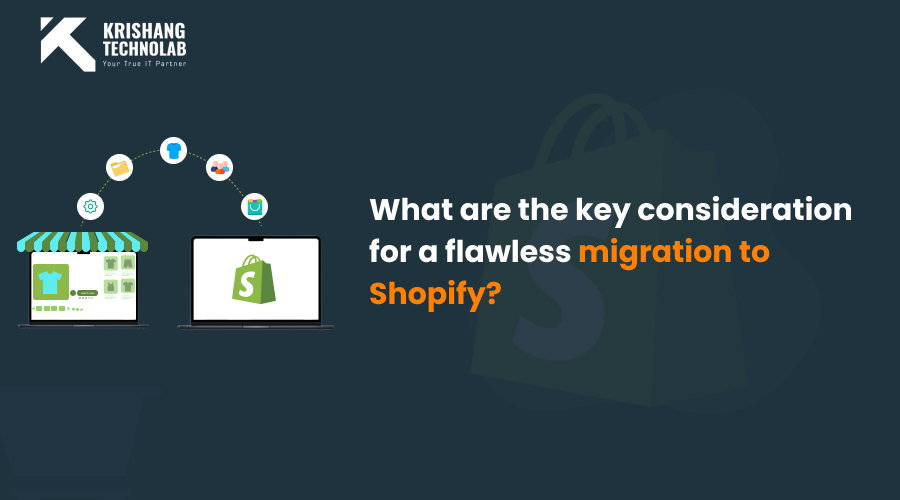Essential Factors for a Smooth Transition to Shopify

Migrations can be tough, be it migrating to another city, or country or migration to Shopify from one platform to another. But well, not all migrations have to be tough- you will know what we mean by that further in this blog.
In this blog, we intend to guide you through everything you need to know about Shopify migration guide and present a Shopify migration checklist to help you understand how a migrate to Shopify could be smooth and flawless. Before beginning with our pointers, we will talk a little about the basics of migrate to Shopify. Let us begin.
What is store migration?
An eCommerce platform migration, also known as re-platforming, occurs when there is a necessity to move a store or website from one platform to another. Shopify is often the preferred choice for this transition. To successfully transfer a website from one platform to another, all aspects including data, content, integrations, and features must be meticulously moved over.
Why Shopify migration?
Well, you might be wondering why Shopify is the best option for your migration needs. Shopify offers numerous benefits that have made it a favored platform for businesses seeking to build or improve their online presence. Here are some of these advantages of Shopify Store Development.
User-Friendly Platform
Shopify is renowned for its intuitive and user-friendly interface, which makes it an easy platform to use for even non-technical users. It becomes easier for them to set up and manage their online stores.
Hosted Solution
Shopify is a fully hosted solution, meaning you won't need to handle server management, software updates, or technical hosting issues. Shopify manages all the technical details, giving you extra time to concentrate on your business.
Scalability
Shopify offers excellent scalability to support the growth of your business. You can effortlessly upgrade your Shopify plan or incorporate additional features and integrations as your business expands.
Mobile Responsiveness
With the rise of mobile shopping, having a mobile-responsive website is essential for any business. Shopify themes are crafted to be mobile-friendly, guaranteeing a smooth shopping experience for customers using smartphones and tablets.
Security and Compliance
Along with various other aspects, Shopify is recognized for its focus on security and compliance, providing services such as SSL encryption, PCI compliance for payment transactions, and consistent security patches to safeguard both your store and customer information.
24/7 Support
Shopify offers round-the-clock customer support through email, live chat, and phone, guaranteeing assistance whenever required. Additionally, the platform provides comprehensive documentation, tutorials, and community forums to support users effectively.
After understanding Shopify migration, we will move forward and uncover some important tips for successful Shopify store migration inducing other factors such as Shopify migration costs, steps, and the process. So, stay with us and read on.
We will begin by understanding the importance of restoring data during migration.
The role of restoring data during migration
Whenever there’s a migration taking place, the major concern is migrating the data successfully. Therefore, backups during migration are of topmost importance. The backups ensure that if anything goes wrong, the data can be restored quickly and nothing is lost in the process. When you hire a renowned Shopify development company, restoring and backing up data becomes smooth and time consuming as well.
Moving ahead, we will talk about the Shopify migration checklist. Have a look as we take you through the checklist.
Shopify migration checklist step by step
Next up, we are going to talk about a few things you must remember while migrating your store to Shopify. As migration could get overwhelming, keeping this checklist handy will help you big time. Let’s begin with the checklist now.
Evaluating and planning the migration
The first step in your migration journey is to evaluate and plan the migration correctly. In order to pull out a smooth and error-free migration, you should evaluate your store’s current performance and see how it is working, what are its pain points and what changes would you like to make in the migration to Shopify. When you migrate a website or store to Shopify, its robust ecosystem can resolve many challenges and help you with a feature-rich and functional website.
Selecting the right migration platform and partner
After evaluating and planning the migration, it’s time to choose the right platform and partner to offer the most secure and functional Shopify migration services. When it comes to the right migration platform, we can vouch for Shopify as it offers a variety of migration tools and apps that work excellently well with other platforms. Moreover, along with the right migration platform, having the right migration partner by your side streamlines the whole process.
Executing the migration meticulously
Now comes the execution part. Execution is a long process which further includes several careful steps. Read on to know these steps below.
Migrating store data
Migrating the data is the most important of all tasks involved in the migration. Your store’s data is the lifeblood of your business. The data includes products, customers, orders, features, functions, and content. Shopify’s tools enable a flawless and smooth data transfer and save you from any loss and error.
Testing thoroughly
Once the data is migrated successfully, it’s time to test and verify the whole data. The whole purpose of this step is to check for any discrepancies in product details, customer information, and order histories. If you have a Shopify website development company by your side, they will take care of the testing and help you stimulate transactions and explore the functionality of your new migrated store.
Post migration optimization
Once the store has been migrated to Shopify and is done with the testing, it needs to be optimized to work effortlessly on the new platform. There are a few things that can help with website optimization. Have a look at them below.
SEO setup
Optimizing the new Shopify store for search engines is the top priority as the store should do better in terms of ranking and reach. The Shopify development company you hire for the migration can help you with setting up redirects for any changed URLs to avoid losing any search engine rankings.
Payment gateway integration
Set up payment gateways to accept payments securely. Shopify supports various payment options like PayPal, Stripe, and Shopify Payments. Moreover, Shopify simplifies offering tax calculations and supporting various payment gateways including Shopify payments.
Monitor performance
The next step is to monitor your Shopify’s store performance post migration. Monitoring Shopify’s performance includes site speed, traffic, conversion rates and customer feedback. Keeping these things in check ensures that the store is performing as per the expectations.
Engaging with Shopify’s community
One of Shopify’s biggest strengths is its vibrant community and massive app ecosystem. When you migrate your existing store. Engaging with Shopify’s community is great to stay updated with all things Shopify. You should engage with forums, explore apps that could enhance your Shopify store’s functionality and stay alarmed to any new Shopify updates.
How much does it cost to migrate to Shopify?
When it comes to the cost of migrating your store to Shopify, there is no fixed amount as such. This is because there are many factors to take into consideration. However, no matter how many factors there are, there are a few range of costs that every migration will have.
List of Factor consideration for Migrate to Shopify
Shopify subscription fees
As Shopify operates on monthly subscription packages, it offers various subscription plans with different features and pricing tiers. There’s also an enterprise-level plan, Shopify Plus, which is priced based on specific business requirements. You can choose the plan which suits your requirements and budget the best.
Migration Tools or Services
If you opt for automated migration tools or services, there can be other additional costs involved. Some migration apps or services may charge a one-time fee or a subscription fee based on the volume of data to be transferred. You can always hire Shopify experts agency to help you with the cost factor during eCommerce store migration to Shopify.
Design and Theme
This is yet another factor that we cannot overlook. While Shopify provides a range of free and paid themes, you can choose to purchase a premium theme or hire a designer to customize the theme to match your brand’s aesthetics. You can hire an expert Shopify web designer to help you with migrating Shopify theme and design and that will eventually add up to your overall costs.
Training and Support
Many businesses choose to set up their Shopify store or train their team to use the platform effectively. If you want to train your team and provide support, it might add to the overall cost of migrating your store to Shopify.
Additional Apps and Add-ons
Shopify offers a wide range of apps and add-ons to extend the functionality of your store. When you migrate your store to Shopify, you can decide whether you want to add additional addons to your store. While some apps and add-ons are free, others may require a one-time payment or a subscription fee which fluctuate the costs.
Wrap UP
As we said before, store migration can be pretty hectic and overwhelming. But you don’t have to worry about a thing when you hire Shopify developers who know Shopify inside out. We can help you migrate any store to Shopify with all the data, features, functions and content intact. discuss with us, you will have to not worry about a thing and leave it on us to carry out a flawless, safe, and secure migration.
Source : https://www.krishangtechnolab.com/key-considerations-for-a-flawless-migration-to-shopify/
